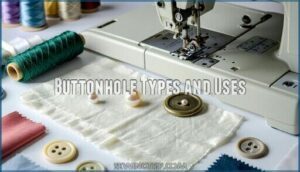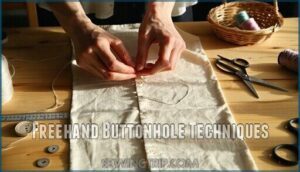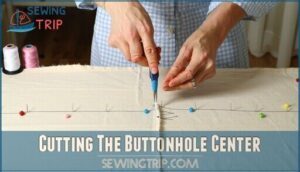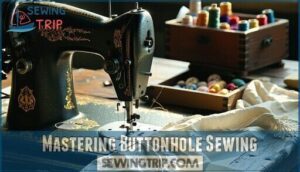This site is supported by our readers. We may earn a commission, at no cost to you, if you purchase through links.
 To sew a buttonhole, you’ll mark your button placement and add interfacing to prevent fabric stretching.
To sew a buttonhole, you’ll mark your button placement and add interfacing to prevent fabric stretching.
For machine buttonholes, attach a buttonhole foot and select the appropriate stitch setting. Test on scrap fabric first—trust me, this saves heartache later.
Start stitching from the bottom, letting the machine create dense zigzag stitches on both sides with bar tacks at each end.
For hand-sewn buttonholes, mark your opening, cut carefully with sharp scissors, then work blanket stitches around the edges for a clean finish. The secret lies in consistent tension and proper thread choice.
Some fabrics demand special techniques that’ll make all the difference.
Table Of Contents
Key Takeaways
- Test your buttonhole on scrap fabric first to avoid costly mistakes – this saves you from ruining your actual garment and helps you dial in the perfect settings for your fabric type.
- Use a buttonhole foot and proper interfacing behind the fabric to create professional-looking results with consistent sizing and prevent stretching or puckering during stitching.
- Match your thread weight to your fabric and maintain proper tension settings – polyester thread works best for stretch fabrics while cotton suits woven materials.
- Cut your buttonhole opening carefully with sharp scissors or a seam ripper, placing pins at each end to prevent over-cutting and maintain clean, precise edges.
Sewing Buttonhole Basics
Learning buttonhole basics sets the foundation for professional-looking garment construction, whether you’re using a sewing machine or stitching by hand.
You’ll discover that proper technique and preparation make the difference between frustrating failures and perfectly functional buttonholes that’ll last for years.
Machine Buttonhole Techniques
Your sewing machine transforms into a precision tool when you master these four essential machine settings.
Modern machines make buttonholes nearly foolproof, but understanding the fundamentals guarantees professional results every time.
Perfect technique beats expensive tools every time when creating professional buttonholes.
- Attach your buttonhole foot – This specialized foot measures your button and creates consistent spacing automatically
- Adjust stitch length to satin setting – Set to zero or near-zero for dense, secure stitches that won’t unravel
- Select proper thread tension – Balanced tension prevents puckering and creates even stitches on both fabric sides
- Control sewing speed – Slow, steady stitching gives you better control over the buttonhole stitch pattern
Your sewing machine settings determine whether you’ll achieve that coveted professional finish or end up with wonky, uneven buttonholes that scream "homemade.
Hand-Sewn Buttonhole Techniques
Through careful fabric preparation and proper sewing tools, you’ll master hand stitching with confidence.
Use silk thread and wax for structure, maintaining consistent thread tension throughout each buttonhole stitch.
Bring your needle up from behind, loop through the buttonhole, then pass through the formed loop.
Hand sewing requires patience—handstitching techniques improve with practice on scrap fabric before tackling your final project.
Buttonhole Placement and Orientation
Getting buttonhole placement right transforms your garment from amateur to professional. Smart buttonhole alignment creates garment symmetry that’s both functional and beautiful.
Here’s your roadmap to perfect closure systems:
- Women’s garments: Place buttonholes on the right side for that classic right-over-left overlap
- Men’s garments: Position buttonholes on the left side, creating the traditional left-over-right closure
- Spacing magic: Keep buttonholes 2.5-3 inches apart, starting ½ inch below the neckline
Horizontal buttonholes handle stress better than vertical buttonholes, especially around the bust area. Follow these sewing guidelines: align with your garment’s center front for perfect fabric orientation.
When you sew buttonhole after buttonhole, consistency in your buttonhole stitch creates that coveted professional finish. Understanding buttonhole techniques is essential for achieving a flawless garment.
How to Sew Buttonholes
Now that you’ve mastered the fundamentals, it’s time to put your skills into action. Creating perfect buttonholes requires proper fabric preparation and the right sewing techniques to achieve professional results every time.
Start by marking your buttonhole placement with precision—measure your button’s diameter and add 1/8 inch for wiggle room. Position your buttonhole foot on your sewing machine and select the appropriate stitch setting. Most modern sewing machines offer either four-step or one-step buttonhole processes that’ll make your life easier.
Here’s your step-by-step roadmap:
- Prepare your materials: Choose quality thread selection that matches your fabric weight
- Stabilize the area: Add interfacing behind the buttonhole location to prevent stretching
- Test first: Practice sewing buttonholes on scrap fabric before tackling your garment
- Follow the sequence: Sew left side, end bar tack, right side, then front bar tack
- Cut carefully: Use a seam ripper with pins at each end to prevent over-cutting
Vertical buttonholes work well for lightweight fabrics, while horizontal ones provide better stability under stress.
Buttonhole Types and Uses
Understanding different buttonhole types helps you choose the right style for your fabric and button combination.
Each type serves specific purposes, from delicate pearl buttons to heavy coat closures that need extra durability.
Eyelet Buttonholes
Eyelet buttonholes create perfect circles for small buttons on delicate garments.
You’ll sew buttonhole stitches around a pre-made hole using an awl or pointed tool.
Choose matching thread colors and appropriate eyelet materials for your fabric selection.
Your sewing machines with buttonhole foot attachments make consistent buttonhole sizes easier.
Practice different buttonhole techniques on scraps first.
For a round buttonhole, consider using machine sewing techniques to achieve the desired shape, and use buttonhole foot attachments for best results.
Pearl Button Sized Buttonholes
Pearl buttons need precise buttonhole sizing to function properly. When you sew buttonhole openings for these delicate buttons, measure the pearl button’s diameter and add 1/8 inch for comfortable passage.
Small holes work best with a narrow zigzag stitch on your machine. Choose stable fabric that won’t stretch around the buttonhole opening. Your buttonhole foot helps create consistent, professional results.
Handsewn buttonholes require extra care with pearl buttons due to their smooth surface and potential fragility during fastening, which demands precise buttonhole sizing and careful handling to avoid damage, ensuring the buttons are securely attached with a narrow zigzag stitch and placed on stable fabric.
Keyhole Buttonholes
Keyhole buttonholes feature a wider opening at one end, perfect for accommodating thick buttons or shank buttons on coats and jackets.
Your sewing machine’s keyhole sewing function creates this teardrop shape automatically.
Select sturdy fabric and adjust thread tension carefully.
These buttonholes distribute stress better than standard rectangular ones, preventing tearing under pressure, and use proper buttonhole tools for clean, professional results, which is why they are ideal for thick buttons.
Rounded Buttonholes
Rounded buttonholes soften your garment’s appearance with their curved edges, perfect for delicate fabrics like silk.
They require precise sewing curves and careful stitch density for professional results. To achieve professional-looking buttonholes, understanding buttonhole techniques is essential for garment sewing.
- Fabric Selection: Choose lightweight materials where rounded edges won’t stress fibers
- Buttonhole Sizes: Mark curves accurately using small templates for consistent rounded buttonholes
- Sewing Technique: Use dense satin stitches and a buttonhole cutter for clean openings
Sewing Buttonhole Tools and Tips
The right tools can transform your buttonhole sewing from a nerve-wracking experience into a smooth, professional process.
You’ll discover how essential equipment like a buttonhole foot, proper interfacing, and the correct thread selection make all the difference in creating sturdy, polished buttonholes every time.
Using a Buttonhole Foot
Your buttonhole foot transforms sewing from guesswork into precision.
Simply snap the foot attachment onto your sewing machine and insert your button into the holder.
Pull down the buttonhole lever and select your machine settings.
The foot automatically measures and creates perfectly sized buttonholes every time.
This sewing machine accessory guarantees consistent stitch control across multiple garments, making professional results achievable for any skill level.
The correct use of a buttonhole foot involves understanding sewing machine foot options, and with the right knowledge, you can achieve professional results.
Interfacing and Stabilizing Fabric
Beyond your buttonhole foot, fabric support creates the foundation for professional results.
Interfacing reinforces thin materials and prevents puckering, while stabilizer materials like tearaway backing eliminate stretching during sewing.
Fusible webs bond interfacing permanently, though sew-in types work better for delicate fabrics.
A proper needle prevents fabric stitch flaws, and this fabric backing transforms tricky buttonholes into manageable sewing techniques, giving you control over even the most stubborn materials, using professional results.
Thread Selection and Tension
Smart thread selection and tension control make the difference between amateur and professional-looking buttonholes. Your sewing machine tension, thread types, and fabric compatibility work together to create flawless results that’ll make you proud.
Perfect thread choice and machine tension turn ordinary buttonholes into professional masterpieces that last.
Understanding the proper sewing thread selection is vital for achieving high-quality stitch quality.
- Thread Types: Choose polyester for stretch fabrics, cotton for wovens, silk for luxury garments.
- Tension Control: Reduce upper tension to 3-4 for balanced stitches without visible bobbin thread.
- Fabric Compatibility: Match thread weight to fabric thickness—40wt works for most projects.
- Stitch Length: Set to satin stitch density for dense, even coverage.
- Bobbin Management: Use matching thread weight in bobbin for consistent tension adjustment.
Hand Sewing Buttonholes
When your sewing machine isn’t available or you’re working on delicate couture pieces, hand-sewn buttonholes offer complete control over your stitching.
You’ll master this traditional technique with practice, creating durable buttonholes that rival machine-sewn ones.
Freehand Buttonhole Techniques
When tackling freehand buttonholes, you’re stepping into hand sewing territory where precision meets creativity.
This technique requires careful Fabric Preparation and Buttonhole Marking since you won’t have sewing machine feet to guide you. Start by measuring your buttonhole length, then mark it clearly on your fabric.
| Step | Technique |
|---|---|
| Mark Length | Measure button width plus 1/8" |
| Cut Opening | Use sharp scissors for clean edges |
| Begin Stitching | Start at one corner with small stitches |
| Maintain Spacing | Keep Freehand Stitches even and consistent |
| Finish Ends | Secure with extra reinforcement stitches |
Unlike machine methods, freehand buttonhole creation demands steady Sewing Precision and patience. You’ll manually stitch each step, controlling thread tension and spacing.
This Hand Sewing approach works perfectly when your machine isn’t available or you’re working on delicate fabrics that need gentle handling. To achieve clean cuts, for the best results, use high-quality sewing scissors.
Backstitches and Blanket Stitches
Once you’ve established your freehand technique, you’ll rely on two fundamental stitch patterns for hand sewing buttonholes.
Start with backstitches to create the foundation lines along each side of your marked opening. These sturdy stitches provide structure and prevent fraying.
Next, work blanket stitches around the entire perimeter, creating that distinctive looped edge.
This hand stitching method requires careful thread control and proper fabric preparation, but mastering these sewing basics will elevate your sewing tutorial skills substantially.
Cutting The Buttonhole Center
Carefully open the center using scissors or seam rippers with precision. Place pins at each end of your marked buttonhole to prevent over-cutting – a common mistake that’ll leave you frustrated.
Cut slowly between the hand-sewn edges, staying centered for buttonhole accuracy. This moment requires steady hands and focused attention.
Mastering the hand sewing techniques is essential for achieving professional-looking results with steady hands.
Mastering Buttonhole Sewing
You’ll reach buttonhole perfection through consistent practice and understanding the fundamentals that separate amateur from professional results.
Master these core techniques, and you’ll troubleshoot problems confidently while creating buttonholes that rival those found in high-end garments.
Practicing on Scrap Fabric
Fabric testing transforms beginners into buttonhole masters.
Choose scrap fabric matching your project’s weight and weave for accurate sewing practice.
Set up your sewing machine with identical thread and settings you’ll use.
Practice routines build muscle memory through repetitive sewing drills.
Test different buttonhole sizes and styles systematically.
Analyze each error to understand tension, spacing, and stitch quality issues before tackling your final garment.
Achieving Consistent Results
Once you’ve practiced enough, maintaining sewing precision becomes second nature.
Focus on machine calibration, fabric tension, and thread selection for professional results. Your sewing machine should deliver identical buttonholes every time with proper stitch control and consistent technique.
- Machine Calibration: Check your sewing machine’s tension settings and buttonhole foot alignment before each project
- Thread Selection: Match thread weight to fabric type – heavier threads for dense fabrics, lighter for delicate materials
- Stitch Control: Maintain steady speed and consistent pressure throughout the buttonhole sequence for uniform results
Troubleshooting Common Issues
Something will inevitably go wrong when you’re learning to sew buttonhole mastery. Don’t panic—most issues have simple fixes that’ll get you back on track quickly.
| Problem | Likely Cause | Quick Fix |
|---|---|---|
| Thread Breakage | Wrong needle size or old thread | Replace needle; use fresh, quality thread |
| Fabric Fraying | No stabilizer used | Add interfacing or tear-away stabilizer |
| Buttonhole Twist | Uneven fabric feeding | Check presser foot pressure; slow down |
| Tension Issues | Incorrect threading or dirty bobbin | Rethread machine; clean bobbin area |
Machine Errors often stem from rushing the process. When Sewing Mistakes happen, stop and assess before continuing. Most sewing machine troubleshooting involves checking the basics first.
Advanced Buttonhole Techniques
Beyond basic buttonholes lies a world of professional techniques that’ll transform your sewing from amateur to artisan.
Master these advanced methods to elevate your craftsmanship:
- Buttonhole Reinforcement with interfacing creates rock-solid foundations for heavy fabrics
- Bound Buttonhole construction delivers couture-level finishes using precise fabric selection
- Buttonhole Twist hand-stitching with perfect thread tension and stitch density for heirloom quality
These techniques require patience, but they’re your ticket to sewing freedom.
Frequently Asked Questions (FAQs)
What are the stitch settings for buttonhole?
Set your machine to buttonhole stitch mode.
Use stitch length zero or "satin" setting.
For width, start full-width for bars, then reduce to half-width for sides.
Practice on scrap fabric first.
How do you fix a buttonhole thats too small?
Imagine your jacket buttons keep slipping through the buttonholes—it’s a frustrating fix.
Carefully cut the bar tack at one end, then stitch a new, narrower bar tack where needed to shorten the opening for your buttons.
Can you sew buttonholes on stretchy fabrics?
Yes, you can sew buttonholes on stretchy fabrics.
Use narrow zigzag stitches instead of straight stitches to prevent distortion.
Add interfacing behind the buttonhole area for stability and practice on fabric scraps first.
What causes buttonhole stitching to bunch up?
Bunching resembles tangled holiday lights—frustrating but fixable.
Wrong tension settings, dull needles, thick fabric layers, or inadequate stabilizer cause stitching to bunch.
Check your tension, replace the needle, and use proper interfacing for smooth results.
How do you reinforce buttonholes on heavy coats?
Reinforce heavy coat buttonholes by applying fusible interfacing behind the fabric, using keyhole buttonholes for thick buttons, and hand-finishing edges with buttonhole twist thread for extra durability.
Why does my buttonhole foot skip stitches?
Your buttonhole foot likely skips stitches due to incorrect needle type, dull needle, improper thread tension, or fabric thickness.
Try a fresh needle appropriate for your fabric weight, adjust thread tension, or use interfacing to stabilize the material, and consider a fresh needle for optimal results.
Conclusion
Mastering how to sew a buttonhole is like learning to ride a bike—once you’ve got it, muscle memory takes over.
Whether you choose machine precision or hand-sewn artistry, consistent practice builds confidence.
Remember to test on scraps, maintain proper tension, and select quality thread for professional results.
With these techniques mastered, you’ll create buttonholes that stand the test of time and wear.












